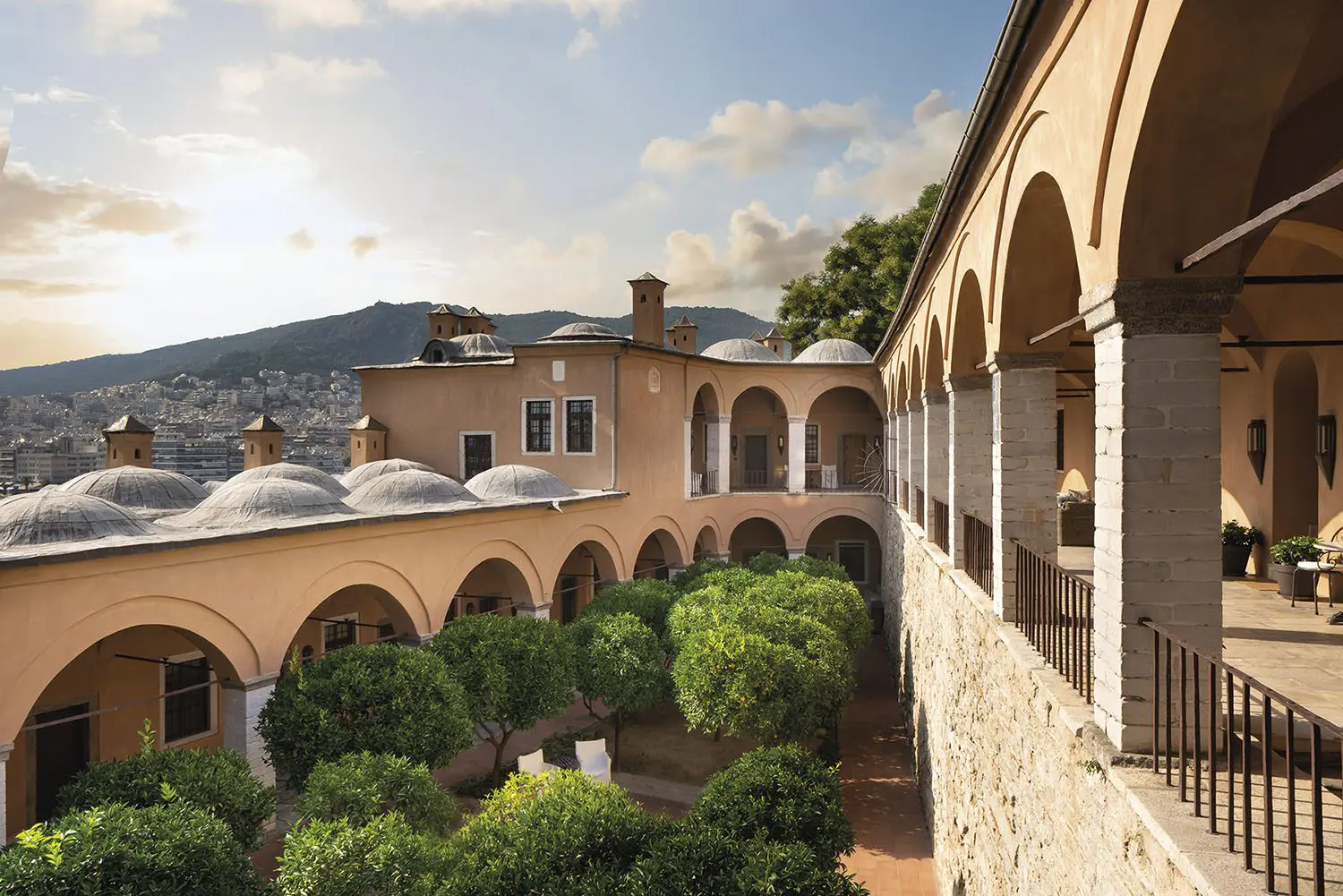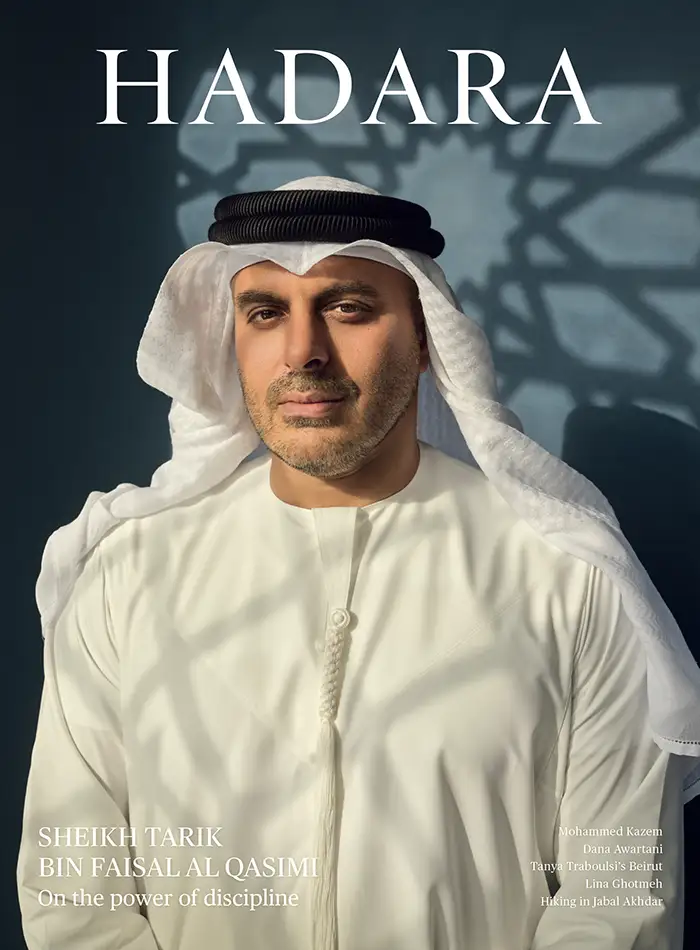The Presence of History
Imaret is a unique boutique hotel in the cultural crossroads of northern Greece.
By Nicola Chilton
A quiet hush embraces the arcaded courtyards of Imaret, a 20-room hotel perched atop Ottoman and Byzantine walls in the coastal town of Kavala in northern Greece. But this is much more than a place to stay.
A boutique hotel in a building with monument status, Imaret is a sensitively renovated Ottoman-era külliye complex, founded by Mohammed Ali Pasha, the early 19th century ruler of Egypt who was born here in Kavala. For around 100 years from 1820, the complex functioned as a charitable institution, including theological and scientific schools, dormitories for up to 300 students, and a public soup kitchen. Imaret’s 20 years as a hotel are only one chapter in its story.
For Anna Missirian, the Kavala native who spent years championing its renovation, and who now runs the complex, Imaret’s role goes far beyond being merely a hotel. She describes Imaret as “a sanctuary, a shelter, and a retreat.”
As I sip tea in the lounge, gazing out of tall windows at a leaden December sky sitting heavily over the bay, Chateau the cat snoozing on the carpet by my feet, I can feel what Missirian means. Within Imaret’s walls, history feels very present, the world outside feels far away, and the sense of timeless calm is broken only by the occasional honk of a boat in the harbour below. It’s like entering another dimension.
Missirian’s connection to Imaret goes back to her childhood. “We couldn’t enter the building, but we could look through small holes in the wall,” she says. At the time, two of the courtyards were closed to the public, but the third—today’s main building, housing guest rooms, a cistern repurposed as a small indoor pool, and a hammam—had become home to refugees from the 1923 population exchange between Greece and Turkey, when more than 1.6 million Greek Orthodox Christians living in Asia Minor and Muslims living in Greece were forcibly moved from one country to the other.
“I needed to understand what was happening,” Missirian says. “It sparked curiosity in me as a child, and I wanted to know why, in a town like Kavala, we had something so different, and who this king of Egypt was who came from here.”

Imaret’s architecture is a mixture of styles, largely Ottoman baroque but with Roman and Byzantine influences in the elegant arches and arcades. The hotel is perched atop Ottoman and Byzantine walls with views across to the seaport of Kavala. This corner of northern Greece has long been a confluence of cultures.
Mohammed Ali Pasha rose to power in the Ottoman military, became the de facto ruler of Egypt from 1805 to 1848, and is considered the founder of the modern Egyptian state. He created this charitable complex as a tribute to his hometown. Today, Imaret remains the property of the Egyptian state under the Ministry of Awqaf, in charge of religious endowments. Missirian has only a 50-year lease.
It took eight years of negotiation to agree a way to save the complex. In 1996, while sitting in a café in the grounds, Missirian decided that something finally needed to be done. Abandoned, the buildings had fallen into decay, their metal elements, like taps and lead roof panels, stolen over the decades to be repurposed as bullets and fishing weights.
“I said to myself, ‘is there no one who can save this, the most beautiful building of Islamic architecture in Greece, if not the whole Balkan area?’ And that’s how it started. I decided to go and see what was happening.”
The Egyptian authorities told Missirian that if she wanted to rent the complex, she needed to come up with a contemporary use for the building—and the idea for the hotel was born.
The property welcomed its first guests in 2004 after a challenging restoration. “Imaret has a very strong identity, as all old buildings do, because they accumulate years of history, knowledge and education,” Missirian says. “I remember the architect wanting to open a hole in a wall to pass a wire through and I was laughing and saying, let’s see how you’ll do it. They found stone that was made up of 70% iron and couldn’t go through.”
Imaret’s architecture is a mixture of styles, largely Ottoman baroque but with Roman and Byzantine influences in the elegant arches and arcades. The terracotta-colour walls are surfaced using a traditional material called kourasani, a combination of sand and crushed glass, ceramic and brick mixed with egg white. What were once dormitories, classrooms and kitchens have been reborn as elegant guestrooms and suites. The former offices have become a light-filled lounge and dining room, where menus offer carefully researched recipes from monasteries and the kitchens of the caliphs. The former mosque now serves as a place for reflection, cultural events, and art exhibitions. Imaret is also home to the MOHA Research Centre, an NGO focused on the study and preservation of the cultural diversity of the wider Mediterranean, highlighting the Islamic Golden Age and its contributions to contemporary science and art.
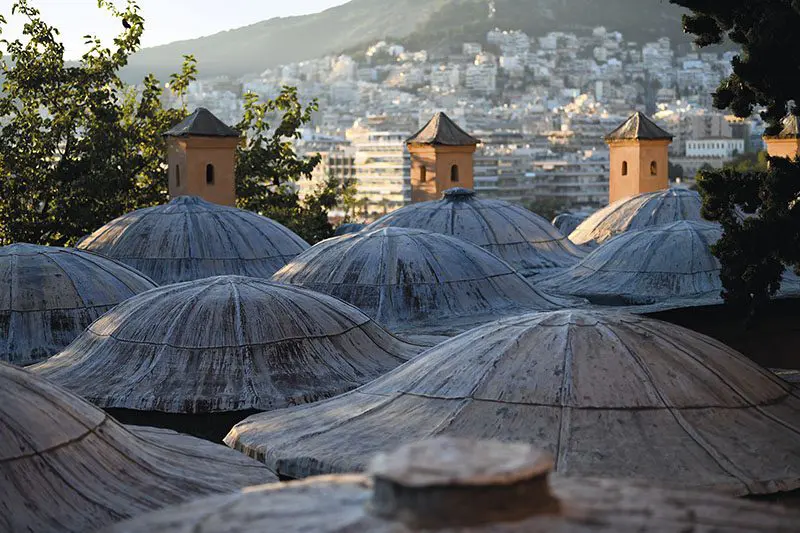

For Anna Missirian, the Kavala native who championed Imaret’s restoration, and now runs the complex, it is much more than a hotel—it is a sanctuary.
Imaret is not Missirian’s home, but when you see her moving through the spaces, stopping to stroke one of the resident cats, loyally followed by Lalique, her Yorkshire terrier, it’s clear that she feels deep affection for the place, treating it with the utmost respect.
“Everything here comes from a lot of research and discussion,” Missirian says. Fabrics are custom-made to imitate early 19th century ways of weaving. Copper sinks and lamps are sourced from Cairo’s Khan El-Khalili bazaar, as are the newer carpets (older ones come from Missirian’s own collection).
Missirian has high expectations of her guests. “If someone is choosing between Mykonos and Imaret, they had better choose Mykonos because when they come here, they will be unhappy,” she says. “This is not a place where having money is enough. Imaret tries to teach.”
Imaret is a place to come to alone in the depths of winter with a good book and a cosy cashmere shawl, to curl up in a chair as the rain falls outside, to hear the thunk of another log being thrown on the fire and the chestnut floorboards creak as tea is brought in. It’s a place to enjoy in summer with a loved one, to sit on the sunny terrace as the waters of the bay sparkle below, the hills around the town looking Monegasque in the afternoon light. It’s a place to enjoy by day, when Aegean sunshine filters through the windows, bathing everything in a warm light that glints off the crystal chandeliers, and to soak up at night, when the courtyards glow with candlelight and log fires crackle around the pool.
It’s a place for those who prefer personality and individuality, for those who have a fascination for history, a desire to learn, and a love for the past. Imaret isn’t for everyone. And it’s all the better for it.
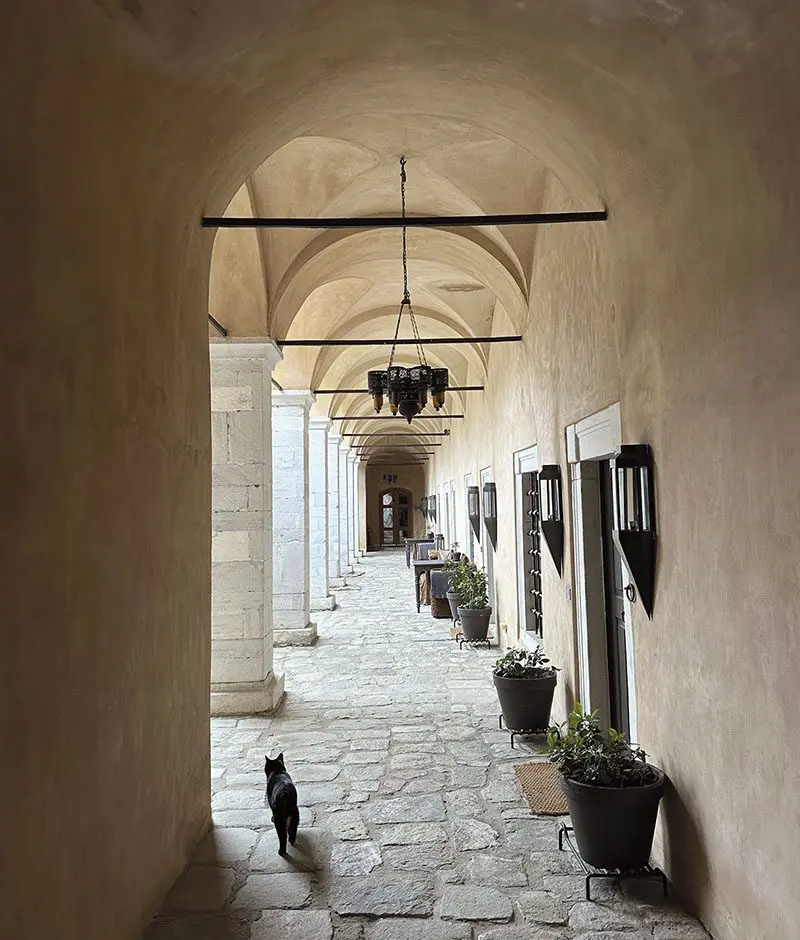
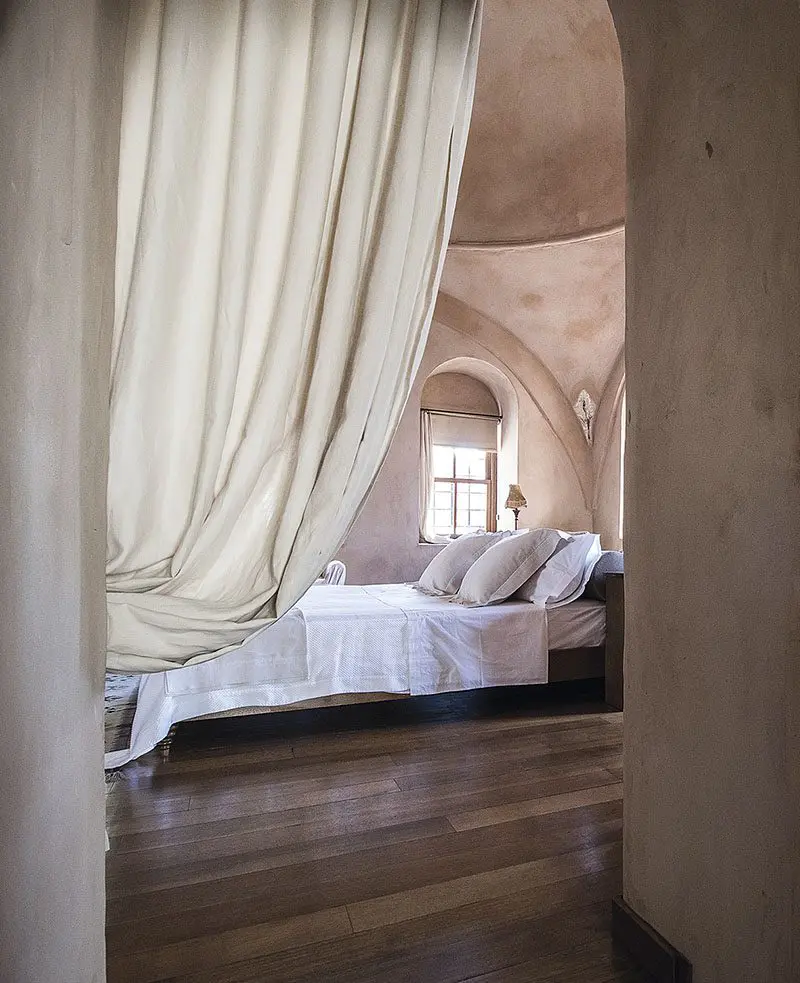
A quiet hush embraces the arcaded courtyards. The hotel offers 20 elegant guestrooms and suites.
ALL IMAGES COURTESY OF Imaret Hotel except the Swimming Pool and Cat in Corridor by Nicola Chilton; Portrait of Missirian by John Gouzidis

